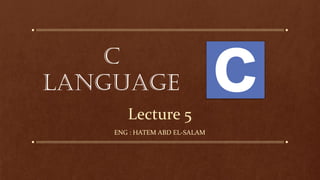
C- language Lecture 5
- 1. Lecture 5 C Language ENG : HATEM ABD EL-SALAM
- 3. String • String is array of characters. It is terminated by a null character 0 • Here, "c string tutorial" is a string. When, compiler encounter strings, it appends a null character 0 at the end of string
- 4. String (Cont.) • Initialization of strings
- 5. Reading Strings from user Using scanf() • The scanf() function only takes the first entered word. The function terminates when it encounters a white space (or just space).
- 6. Reading Strings from user • Example
- 7. Reading Strings from user Using getchar() • In the program above, using the function getchar(), ch gets a single character from the user each time.
- 8. Reading Strings from user Using standard library function • To make life easier, there are predefined functions gets() and puts() in C language to read and display string respectively.
- 9. String (Cont.) Passing Strings to Functions
- 10. String (Cont.) • Strings handling functions are defined under "string.h" header file.
- 11. EXERCISES
- 12. Exercises • C Program to Find the Length of a String • C Program to Find the Frequency of Characters in a String • C Program to Find the Number of Vowels, Consonants, Digits and White space in a String • C program to Concatenate Two Strings • C Program to Copy a String • C Program to Convert string to lowercase • C Program to Convert string to uppercase
- 14. Pointers Address in C • If you have a variable var in your program, &var will give you its address in the memory, where & is commonly called the reference operator. • You must have seen this notation while using scanf() function. It was used in the function to store the user inputted value in the address of var.
- 15. Pointers (Cont.) Pointer variables • In C, there is a special variable that stores just the address of another variable. It is called Pointer variable or, simply, a pointer. • Above statement defines, p as pointer variable of type int. • Note: The * sign when declaring a pointer is not a dereference operator. It is just a similar notation that creates a pointer.
- 16. Pointers (Cont.) Reference operator (&) and Dereference operator (*) • & is called reference operator. It gives you the address of a variable. • Likewise, there is another operator that gets you the value from the address, it is called a dereference operator (*).
- 18. Explanation of program 1. int* pc; creates a pointer pc and int c; creates a normal variable c. Since pc and c are both not initialized, pointer pc points to either no address or a random address. Likewise, variable c is assigned an address but contains a random/garbage value. 2. c=22; assigns 22 to the variable c, i.e.,22 is stored in the memory location of variable c. Note that, when printing &c (address of c), we use %u rather than %d since address is usually expressed as an unsigned integer (always positive). 3. pc=&c; assigns the address of variable to c to the pointer pc. When printing, you see value of pc is the same as the address of c and the content of pc (*pc) is 22 as well. 4. c=11; assigns 11 to variable c. We assign a new value to c to see its effect on pointer pc. 5. Since, pointer pc points to the same address as c, value pointed by pointer pc is 11 as well. Printing the address and content of pc shows the updated content as 11. 6. *pc=2; changes the contents of the memory location pointed by pointer pc to 2. Since the address of pointer pc is same as address of c, value of c also changes to 2.
- 19. Pointers (Cont.) Common mistakes when working with pointers • In both cases, pointer pc is not pointing to the address of c.
- 20. Pointers (Cont.) Pointers and Arrays • Consider an array: • In C programming, name of the array always points to address of the first element of an array. • In the above example, arr and &arr[0] points to the address of the first element
- 21. Pointers (Cont.) Pointers and Arrays • Since, the addresses of both are the same, the values of arr and &arr[0] are also the same. • In C, you can declare an array and can use pointer to alter the data of an array.
- 23. Pointers (Cont.) Call by Reference • When a pointer is passed as an argument to a function, address of the memory location is passed instead of the value. • This is because, pointer stores the location of the memory, and not the value.
- 25. Explanation of program 1. The address of memory location num1 and num2 are passed to the function swap and the pointers *n1 and *n2 accept those values. 2. So, now the pointer n1 and n2 points to the address of num1 and num2 respectively. 3. When, the value of pointers are changed, the value in the pointed memory location also changes correspondingly. 4. Hence, changes made to *n1 and *n2 are reflected in num1 and num2 in the main function.
Editor's Notes
- Address of c= 2686784